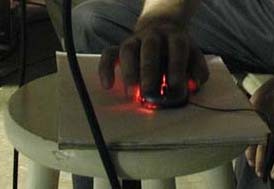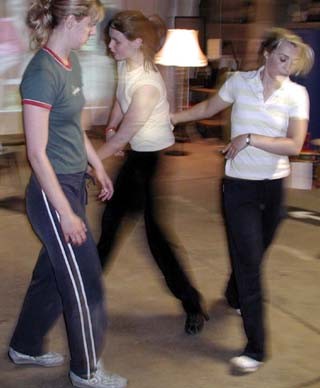"interesting phenomena" - a history of the personal computer
- an evolving experiment in the use of multimedia in performance.
Originally conceived as a "performance history of the personal computer" in which a dancer or dancers use digital technologies to simulate the work of six different creative artists, a poet, a musician, a painter, a photographer, a video artist, an internet artist at different stages in the development of the personal computer, the proposed series of works numbers eight in total (including an introductory piece "in a loop state" and a finale - the ideas for which we are still researching.)
The ideas for the "interesting phenomena" series have come from a range of sources:
Money
The initial impetus (isn't it always) being the possibility of raising
funding for the realisation of some (if not all) of the individual performances.
So far, two of the pieces have received funding - "Hello World (&
other monospaced fonts)" and "Super Muso Bros". A third
piece "VPaint Delta" is currently in development in collaboration with the Interdisciplinary Centre for Scientific Research in Music (the University of Leeds).
Books
The title for the series comes from a quotation from Gregory Bateson's
"Mind and Nature" discovered at random while looking for texts
for tape loops sometime in the 1980s.
"interesting phenomena occur when two or more rhythmic patterns are combined"
At some primitive level, this is the key aesthetic idea underlying all the production of ondoloop ltd (distorted and twisted through years of experience with analog synthesis techniques).

DanceTech
You don't have to spend much time researching MIDI, multimedia and performance
around the internet before coming upon the dance and technology mailing
list. This seems to be where some of the most interesting discussion of
the use of technology in performance is happening. Obviously, the big
influence on us here was our decision to work with dancers and to develop
"interesting phenomena" as a "dance" project. These
days though, we would prefer to call it a "performance" project.
None of the core ondoloop team have any dance experience or training and,
as the series develops, our main concerns are less to do with how to track
or wire up performers and relate this to sound and image, and more with
how the different elements we are working with can be combined together
to construct some kind of (relatively) meaningful narrative. In fact,
it has been suggested that we could call our work "techno theatre"
- though this is probably more an ideal we are striving towards than an
achievement we have already realised.

Software
One of the mailings which appeared on the dance-tech list a couple of
years ago, was from someone wondering why in performances using digital
technology, there was always such fuss made about what software was being
used to create the performance - suggesting that the only people who went
to such performances were those who wanted to see the technology in action
rather than the performance itself. It was in reference to this that the
"history of the personal computer" became one of the themes
of this work - it enables us to talk about computers and software in performance
without having to list the software/hardware we are actually using. Each
of the main pieces in the series references historical software at different
stages in the evolution of the pc (see below). Cheap joke or creative
leap ?

Emulation
So, once we start talking software, one of the things we begin to notice
is that applications were/are often designed to emulate other activities
(typing, sound recording, painting) - maybe at its most important as the
PC began to spread into the creative industries - so this became the second
theme of the series, one which seems to fit fairly well with the "history
of the personal computer" theme: we could use digital technology
to emulate the creative processes of different artists. The kinds of artists
and digital technology we intend to work with/reference over the course
of the series are:
Poet -> Basic.
Musician -> Commodore 64 games music.
Painter -> Amiga DPaint IV.
Photographer -> Adobe Photoshop.
Video artist -> Quicktime.
Internet Artist -> HTML 3.2.
The Intro "in
a loop state" basically set us going and we're still collecting ideas
for the Finale.
Cave Art
Inside the cave, the audience is sitting on the floor. In front of them,
someone is telling a story. Someone else paints details from the story
onto the wall of the cave as the tale is told. A couple of performers
also act out parts of the story as it unfolds, shifting the audience's
attention from painting to performance and back again. While a dancer
dances to the rhythms provided by a pair of musicians whose sound is determined
by the natural reverb /echo of the cavern. We add the electricity.
- the computer as a tool of magical transformation -
http://www.ondoloop.org/intphen/concept.html